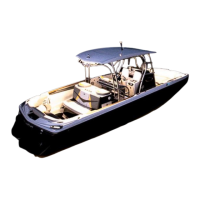The following procedures will help avoid most potential types of damage during
storage for a period not to exceed five (5) months!
Because of the complexity of preparing a boat for proper winter storage, as
well as the possibility of extreme damage to the drive train if a preparation er-
ror was made during winterization, MasterCraft recommends scheduling an
appointment with an authorized MasterCraft dealer’s service department to
permit a technician to perform all winterization procedures.
Storageorwinterlay-uprequiresspecialpreparationtopreventdamagetotheboat.Sincewinterstorageisanannualevent,itpresentsanex-
cellentopportunitytoperformtheannualmaintenanceatthistime,dependingupontheamountofusage.CheckwithanauthorizedMasterCraft
dealer’s service department regarding the boat’s needs to determine if this is the appropriate time for annual service.
Withoutproperpreparation,storageforlongperiodsoftime(atanytimeoftheyear)maycauseharmtovariouscomponentsoftheboatand
drivetrain.Also,iftheboathasbeenstoredinbelow-freezingtemperatureswithwaterinsidethebilgeorenginecoolingsystem(includingthe
heateror,shower,ballasttanks,washdowntanks,coolers,oranycontainerorareainwhichwaterhasbeenlocated),thisconditionmayresultin
majordamagefromfreezing,whichwouldnotbecoveredunderthewarranty.
Refertotheengineowner’smanualforguidanceregardingstorageandwinterizationoftheengine,transmissionandcomponentsofthedrivetrain.
Storage and
Winterization
General Preparation
Beforestartingyouwillneedthefollowingsupplies:
• Sta-Bil®GasolineStabilizer
• Fuellter
• Lowtacktape
Fuel System Treatment
This preparation needs to be done prior to removing water from the
engine, if that will be part of the process.
Boats that are going to be storedforextendedperiods(morethan
forty-ve[45] tosixty[60] days)orwinterized shouldhave attentionfor
thefuelsystem.EvenTOPTIERgasolineswillexperiencesomeseparation
of elements and settling during these periods. Of considerable concern is
thatwatercondensationwilloccurwithinthefuelsystem,andwaterisan
enemyofgood-startingandrunningenginefuelsystems.Therefore,follow
thisprocedure:
• The fueltank shouldbe ninety-to-ninety-vepercent(90-95%)full
ofTOPTIERgasoline.Thisallowsforminimalroominwhichaircan
oxygenatethefuelduringdiurnalcycles(dailyperiodsofexpansion/
contraction of gasoline vapors and air as a result of temperature
changes). As temperatures rise in the tank, the pressure also rises,
pushing out gasoline vapor-and-air mixtures. When the temperature
falls,pressurelowersandthesystemwillseektodrawfreshairand
watervapor(dependingonthehumiditylevel)intothetank.Freshair
is replaced with “light ends,” which are low-boiling components that
vaporize at ambient temperatures. Light ends are required during
coldstartstovaporizethefuel.Sincethedailydiurnalcycleselimi-
natethelightends,anearlyfulltankhelpstominimizetheairvolume
enteringthesystem.
• Addabiocideadditiveinthefueltanktolimitmicrobialgrowthin
gasoline.Followthedirectionsprovidedbythestabilizer’smanu-
facturer.
• Addafuelstabilizer,suchasSta-Bil
®
,tothefueltank.Followthe
directionsprovidedbythestabilizer’smanufacturer.
• Runtheengineforatleastfteen(15)minuteswhileinabodyof
water. This allows for the circulation of the additives throughout
thefuelsystem.
• Ifpossibleduringstorage,thetankventsshouldbesealed.Ifthe
ventissealed,thetankmustNOTbecompletelylled.Aninety-
to-ninety-vepercent(90-95%)lledtankallowsroomforexpan-
sion, which will be required at certain times when temperatures in-
crease.Thehydrocarbonsingasolinereactwithnaturallyoccurring
oxygenandcreateaby-productknownas“gum.”Thesubstance,
asthenameinfers,plugsupfuelltersandinjectors.Sealingthe
tankhelpsreducegummingbysignicantlylimitingtheamount
ofoxygenavailableforinteractionwiththehydrocarbons.
Completely filling the fuel tank prior to storage and then
sealing the fuel tank vent does not allow room for neces-
sary expansion. This can result, in extreme conditions, in
fuel tank rupture. Such release of fuel into the boat and
potentially into the storage area could result in substantial
damage to the boat and contact with any spark (such as a
flame-producing pilot light in a heater) could also result in
property damage and serious injury or death.
Itisdesirableto keepthefuel’stemperaturebelow80 F.(26C.)
The gumming will increase as temperatures increase.
NotethatfuelstabilizersworkONLYinfreshgasoline.Stabilizers
willnotcureoxygenatedgasoline.Addingastabilizerwhentheboatis
being prepared for outings after storage will NOT clean the gumming
MasterCraft 2012 Owners Manual • Care and Maintenance • Page 4-20

